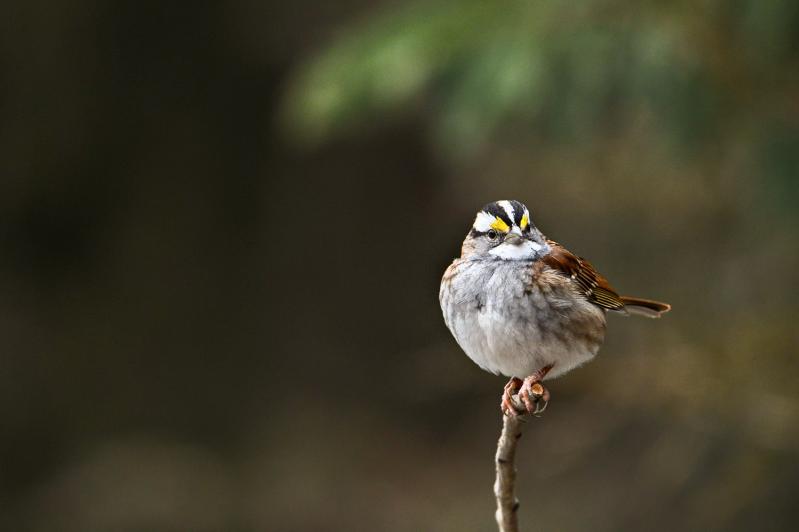In the 1962 Aldous Huxley book “Island,” specially trained mynah birds exhort people to pay attention to the present. “Here and now! Here and now!” they call from the trees.
We don’t yet have the technology to teach our birds how to make us more present. Even if we could train wild birds, given the direction our culture seems to be moving, we’d probably train them to deliver packages from Amazon.
When people talk about the white-throated sparrow, they often refer to its song. It’s a sweet whistle, two slow introductory notes, one low and one higher, followed by nine quick notes, all the same pitch. “Essentially the song is a lament — a lament which is wistful and ineffably plaintive, but in which there is no despair, only sweet hopefulness,” said George Gladden in “Birds of America,” a collection edited by T. Gilbert Pearson.
Depending on where people live within the range of the white-throated sparrow, they put different words to its notes. In Canada, people hear it as “Oh sweet, Canada, Canada, Canada.” In Massachusetts, where the white-throated sparrow is affectionately called the “Peabody bird,” people hear “Old Sam Peabody, Peabody, Peabody.” And a farmer in the Midwest, fraught with indecision about what crop to plant, heard a white-throated sparrow sing “Sow wheat, Peverly, Peverly, Peverly.”
In the winter, we don’t hear that song often, but the bird does sing a type of evening song. Frank Chapman, in his 1901 book “Bird Life,” writes of the winter white-throats, “If you chance to be near their home at bedtime you will hear this chink note given as a ‘quarrier’s chorus.’ Finally, as the gloom deepens, it will cease, and from the dark depths of the thicket will come only the cozy, contented twitterings of the birds wishing one another good night.”
During a South Fork winter, no sparrow is more numerous. In fact, this year on the Montauk count a new all-time high of 1,164 white-throats was tallied. They are often found in gangs of six to 12 birds and are one of our most common feeder birds.
Other than its song, you could easily ignore it and take the white-throated sparrow for granted. Like gulls, sparrows are sometimes lumped together. Birders have been known to derisively refer to the group as “little brown jobs.” Yet on the East End, one could rather easily see 15 species of sparrow in a year.
To distinguish sparrows by their plumage is not always easy, but the white-throated sparrow stands out. It’s large for a sparrow and appears mostly brown on its back and gray on its face and breast. Pretty dull at a glance, but look closer and you’ll see more detail. It sports a clean white throat, bold white eyebrow, and black-and-white crown. Just beyond its beak is a yellow spot, then its eye, and then a crisp black eyeline that extends to the back of its head.
You can hear them low in bushes, hopping and foraging in the leaf litter. If you want an exercise, try to hunt like a white-throated sparrow. Stand with your feet about hip width apart. Now, jump forward, but the second you land, slide your feet back to where you started. Now, imagine you’ve uncovered something and quickly dive face-first into the ground to eat it. Reminder: I’m not a fitness trainer.
When they’re not under your feeder in a little sparrow mosh pit, fighting over bits of millet and sunflower, they’re eating seeds of grass and weeds. That’s why fallow fields are wonderful spots to see sparrows; they’re like gigantic bird feeders. The field just east of the Sagg Bridge holds many sparrows, as does EECO Farm on Long Lane. They also eat a large variety of berries and even wasps and stinkbugs. So, they’re quite beneficial, destroying weed seeds and eating pests.
White-throated sparrows nest north of us, across the Adirondacks to Massachusetts, Maine, and across the boreal forest of Canada. It’s surprising, given what I just said about finding these birds in local fields, but they’re really known as forest sparrows. My most memorable white-throated sparrow experience was not on the East End, but in Maine. I woke one summer morning at sunrise to their song ringing out from the surrounding pines. It felt as if there were 10 birds singing in each tree. It was overwhelming.
In my first “On the Wing” column, I asked people to simply notice birds. Maybe the challenge of winter white-throated sparrows lies not in their identification or scarcity, but in not dismissing them. Maybe these quiet winter birds have something to say to us after all. Circling back to Aldous Huxley, could we use them as a tool? A reminder to pause, think “here and now,” and let the other stuff go, even if for a second?
After all, before we know it, it will be spring, and they’ll be gone. Silly humans north of us will struggle to attach our limited language to their limitless song.
Are you paying attention to your birds? See anything interesting? Write [email protected] with local sightings.

